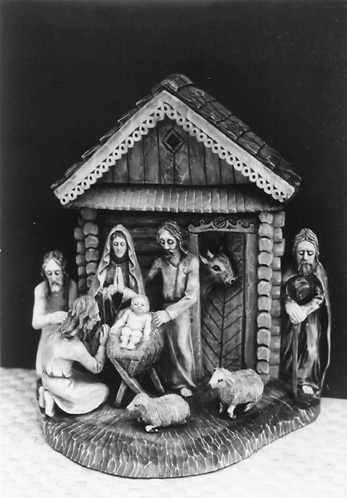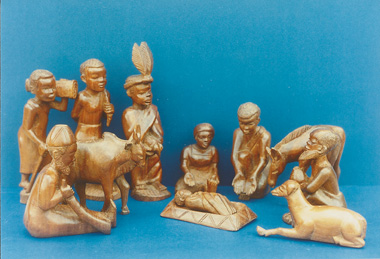
"There is beauty in the event depicted, which holds so much joy and
hope for the Christian world. There is beauty in the undeniable artistic
skill of those who made the nativities. There is beauty in seeing nativities
made to reflect indigenous culture, reflecting how deeply the nativity
story has been absorbed by different societies."

Magazine
Winter/Spring 2002
 A
confluence of faith, art, and cultures
A
confluence of faith, art, and cultures
by Jim Govan ’58
The crèche is perhaps the most universal of Christmas traditions.
Growing out of liturgical devotions of the Middle Ages and popularized
by St. Francis' Christmas Mass in 1223 that included a nativity scene
with live animals, the tradition now reaches around the world. My late
wife Emilia and I began collecting crèches about 30 years ago.
Today the collection consists of over 300 crèches from more than
eighty countries.
For us the collection represented a confluence of faith, interest in art,
especially folk art, and curiosity about the cultural diversity of the
world. One of our goals was to reflect as many cultures as possible. We
were fascinated by how differently artists around the globe depicted this
singular event.
There is beauty in the event depicted, which holds so much joy and hope
for the Christian world. There is beauty in the undeniable artistic skill
of those who made the nativities. There is beauty in seeing nativities
made to reflect indigenous culture, reflecting how deeply the nativity
story has been absorbed by different societies.
Although the collection bears our name, it is really the product of many
people. Friends, colleagues, and acquaintances have either directly contributed
pieces to the collection or served as links in a chain of contacts in
finding crèches. Just this year, four colleagues working in Africa
sent nativities to me. A Catholic priest in Arizona I know only through
telephone contact found a Navajo carver for me who carved one of the most
spectacular nativities in the collection. A New Zealand artist I know
only through e-mails made a crèche for me, upon request, in the
tradition of the Maori culture of New Zealand.
Among my personal favorites is a Lithuanian crèche. Being of Lithuanian
ancestry, I had long sought a crèche to reflect my heritage. Finally
I connected with a Lithuanian-American who knew a young Lithuanian sculptor.
I asked the young man to make a nativity as he would conceive it; he had
never made a nativity.
The result was a marvelously carved piece. Made from a single piece of
tree trunk, the figures are carved as very humble, not particularly handsome
people. There is no regal air. The nativity represented the simple peasant
origins of my maternal ancestors. I heard that the artist, Vladas Rakuckas,
went on to make many more nativities, and I took some pride in ours being
the first.
A crèche from Malawi was another favorite of Emilia's and mine.
In so many ways, this nativity reflected what the collection meant to
the two of us. It was exquisitely carved and totally indigenous. The three
kings represent three proud tribal peoples of Malawi—the Yao, the
Chewa, and the Ngoni. They and the shepherds bear local gifts. Mary sits
on a dirt floor and Joseph crouches. Both extend their arms in deference
to the Child.
But the real beauty of this nativity is that it can be seen as a universal
experience, if not in terms of a Divine Son, then in terms of the birth
of a child which unites all humanity. The nativity was carved by a Muslim
artisan under the training auspices of a Catholic art center, and was
found and given as a gift to Emilia and me by a Jewish friend.
I continue with the crèche collection in memory of my beloved friend
and wife, Emilia. She was a college teacher, manager in the executive
and legislative branches of the government, a lawyer, and a “fellow
crèche aficionado” as a recent Washington Post article described
her. The two of us enjoyed searching out nativities in our travels. While
she tried to contain my urge to collect, she delighted in presenting me
with some unusual nativity she had found. In her last weeks, she made
me promise more than once to carry on with the collection. So I do.
And that is its ultimate beauty. It represents a special facet of a lifetime
shared in so many ways. The collection not only contains the beauty of
faith, artistic skill, and human diversity, and the beauty of the social
experiences that built the collection; now it contains the beauty of the
care, delight, and pride that Emilia bestowed upon it.
The James and Emilia Govan Crèche Collection was displayed in
December at the John Paul II Cultural Center in Washington, D.C. You may
contact Jim Govan at:JLGovan@aol.com
Return to the table of contents
